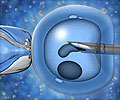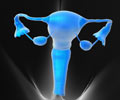A new study has suggested that transferring just a single embryo in IVF to reduce the chance of riskier multiple births could increase the pregnancy rate among a group of women.
A new study has suggested that transferring just a single embryo in IVF to reduce the chance of riskier multiple births could increase the pregnancy rate among a group of women.
The groundbreaking study, by fertility specialists at Guy's and St Thomas' Hospital, developed a technique that involves growing the fertilised embryos for a couple of extra days in the laboratory and identifying the best single "blastocyst," as the embryos are then known, to boost the chances of success.The research team is hoping that the new technique will be adopted as a standard approach by IVF clinics that are struggling to decrease the burden of twin and triplet births.
Traditionally, IVF has involved implanting several embryos into the womb which increases both a woman's chances of having a baby but also her likelihood of having a multiple pregnancy, thus raising the risks of potentially fatal premature birth and pre-eclampsia and making surviving babies more prone to cerebral palsy.
Now the Guy's and St Thomas' Hospital team has claimed that Single embryo treatment or Set can be more likely to result in the birth of a child than the multiple method.
For the study, the researchers gave one group of women multiple embryo transfers, which resulted in an overall pregnancy rate of 27 percent of which 32 percent were multiple pregnancies.
A second group who were given selected Set brought a 32 percent pregnancy rate with 17 percent multiple pregnancies.
Advertisement
The study is published in the British Journal of Obstetrics and Gynaecology (BJOG).
Advertisement
SRM/L









